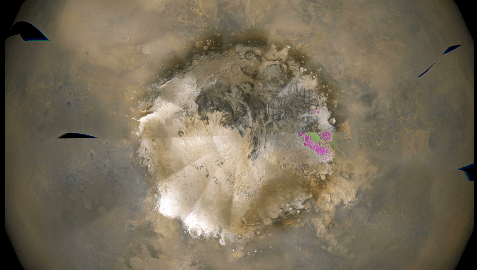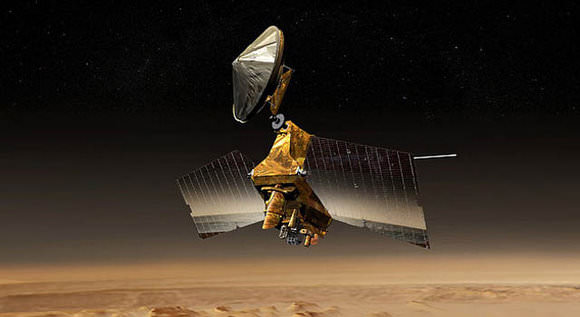If you think about it, those hypnotizing patterns of swirling clouds you see in TV weather reports are pretty amazing: satellites let us see what’s happening in the skies all over the world. But these days, that kind of global vision even goes beyond the Earth. The Mars Reconnaissance Orbiter makes daily weather observations of the Red Planet, and mission scientists regularly compile the pictures into movies that are available online. The result is that anyone can follow along as fierce dust storms rage across the plains of Mars, clouds cling to the peaks of towering volcanoes and polar ice advances and retreats.
On board the MRO is a wide-angle camera called the Mars Color Imager (MARCI) that scans the face of Mars in both visible and ultraviolet light. MARCI views Mars from pole to pole, snapping dozens of images every day that are combined into a global map with resolution comparable to weather satellites at home.
This daily weather report helps Mars explorers understand day-to-day events, as well as seasonal and annual changes on the Red Planet. Sometimes the weather watch also gives rover drivers a crucial warning when a storm might be headed in the direction of Spirit or Opportunity.
The weather images can be striking and intriguing. This animation shows the south pole of Mars during a period of about a month earlier this year, when storms raged along the retreating edge of frost in the polar cap. You can see giant, swirling clouds of dust, as well as the changing shape of the cap as it shrinks with the approach of Summer.
Malin Space Science Systems is the firm that built and operates MARCI for NASA’s Jet Propulsion Laboratory. They post weekly movies that show a spinning, global view of the most recent Martian weather. You never know what you’ll see each week, but a careful look often turns up water ice clouds, wind storms or the giant canyon Valles Marineris filled to the brim with dust.
The descriptions that Malin scientists write to accompany each movie are fascinating. They sound both as exotic as a science fiction novel–and as routine as your local weatherman’s report on the evening news. One sample:
“A large dust storm moved south down the Acidalia/Chryse/Xanthe corridor, partially spilling into eastern Valles Marineris at the beginning of the week. From there the storm moved over Thaumasia and Argyre, picking up intensity as it moved into the subtropics of Aonia and Icaria/Daedalia… Dust storms and water-ice clouds also formed in the northern mid-latitudes, with more notable activity occurring over Deuteronilus and Utopia. The increased amount of dust activity on the planet has created a haze that lingers in the atmosphere and has caused skies over both Opportunity and Spirit to be hazy during the past week.”
That’s why Mars fascinates. It’s an alien world that in some ways is tantalizing similar to home.
MARCI will be turned back on in early December after a hiatus of a few months. Previous weather movies are still online.


